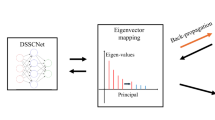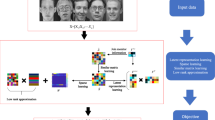Abstract
Low-rank representation (LRR) is a very competitive technique in many real-world applications for its robustness on processing noisy or corrupted data. In this paper, a multi-dictionary induced LRR method (MDLRR) is proposed. Different from traditional LRR methods with each data point being treated equally, in MDLRR, the importance of each data point is scaled up or down independently by a penalty factor. This penalty factor of the data point is the sum distance between it and rest ones, and is considered as a metric of the probability that the data point is an outlier. And these factors form a penalty dictionary which is imposed on a dataset to achieve better low rank structure with clean data being promoted. To learn common view-free low-rank structure in multi-view datasets, multiple dictionaries are used in our proposed method. Also, a multi-manifold regularization, denoted as MDLRR-MM, is adopted for keeping multiple manifolds in learning multi-view low rank data representation. Thus, our MDLRR-MM can benefit from both learning multiple local manifolds and global low-rank subspace in multi-view datasets. Extensive experimental results on a variety of applications, including background modeling from video, face recognition, and denoising from multi-view images, show that MDLRR-MM significantly outperforms several state-of-the-art low rank methods, in subspace clustering and classification with data recovery from multi-view noisy data, and it also presents its robustness in the moderate noisy scenarios.







Similar content being viewed by others
References
Zeng X, Hu R, Shi W, Qiao Y (2021) Multi-view self-supervised learning for 3d facial texture reconstruction from single image. Image and Vision Computing 115:104311
Wang Y, Zhang W, Wu L, Lin X, Zhao X (2017) Unsupervised metric fusion over multiview data by graph random walk-based cross-view diffusion. IEEE Transactions on Neural Networks & Learning Systems 28(1):57–70
Wang Y, Lin X, Wu L, Zhang W, Zhang Q, Huang X (2015) Robust subspace clustering for multi-view data by exploiting correlation consensus. IEEE Transactions on Image Processing A Publication of the IEEE Signal Processing Society 24(11):3939–49
Li N, Wen L, Dong X, Cai J (2018) An exemplar-based multi-view domain generalization framework for visual recognition. IEEE Transactions on Neural Networks & Learning Systems 29(2):259–272
Xiao Q, Dai J, Luo J, Fujita H (2019) Multi-view manifold regularized learning-based method for prioritizing candidate disease mirnas. Knowl-Based Syst 175:118–129
Zhang C, Fu H, Hu Q, Cao X, Xie Y, Tao D, Xu D (2018) Generalized latent multi-view subspace clustering. IEEE Trans Pattern Anal Mach Intell, 1–1
Zhang G-Y, Zhou Y-R, Wang C-D, Huang D, He X-Y (2021) Joint representation learning for multi-view subspace clustering. Expert Systems with Applications 166:113913
Rupnik J, Shawe-Taylor J (2010) Multi-view canonical correlation analysis. In: Conference on Data Mining and Data Warehouses (SiKDD 2010), pp 1–4
Candès EJ, Li X, Ma Y, Wright J (2011) Robust principal component analysis?. Journal of the ACM (JACM) 58(3):1–37
Liu G, Lin Z, Yan S, Sun J, Yu Y, Ma Y (2013) Robust recovery of subspace structures by low-rank representation. IEEE Transactions on Pattern Analysis & Machine Intelligence 35(1):171–184
Peng Y, Lu BL, Wang S (2015) Enhanced low-rank representation via sparse manifold adaption for semi-supervised learning. Neural Netw 65(C):1–17
Deng T, Ye D, Ma R, Fujita H, Xiong L (2020) Low-rank local tangent space embedding for subspace clustering. Inf Sci 508:1–21
Du S, Ma Y, Ma Y (2017) Graph regularized compact low rank representation for subspace clustering. Knowl-Based Syst 118:56–69
Lu X, Wang Y, Yuan Y (2013) Graph-regularized low-rank representation for destriping of hyperspectral images. IEEE Transactions on Geoscience & Remote Sensing 51(7):4009–4018
Liu R, Lin Z, De la Torre F, Su Z (2012) Fixed-rank representation for unsupervised visual learning. In: 2012 IEEE Conference on Computer Vision and Pattern Recognition. IEEE, pp 598–605
Wei L, Wang X, Yin J, Wu A (2017) Self-regularized fixed-rank representation for subspace segmentation. Inf Sci 412:194–209
Bao BK, Liu G, Xu C, Yan S (2012) Inductive robust principal component analysis. IEEE Trans Image Process 21(8):3794–3800
Yang X, Jiang X, Tian C, Wang P, Zhou F, Fujita H (2020) Inverse projection group sparse representation for tumor classification: A low rank variation dictionary approach. Knowledge-Based Systems 196:105768
Wang Q, He X, Li X (2018) Locality and structure regularized low rank representation for hyperspectral image classification. IEEE Trans Geosci Remote Sens 57(2):911–923
Wright J, Ganesh A, Rao S, Ma Y (2009) Robust principal component analysis. Exact recovery of corrupted low-rank matrices, 58 1(3):289–298
Peng Y, Ganesh A, Wright J, Xu W, Ma Y (2012) Rasl: Robust alignment by sparse and low-rank decomposition for linearly correlated images. IEEE Transactions on Pattern Analysis & Machine Intelligence 34(11):2233–46
Wang Y, Peng J, Zhao Q, Leung Y, Zhao X. -L., Meng D (2017) Hyperspectral image restoration via total variation regularized low-rank tensor decomposition. IEEE Journal of Selected Topics in Applied Earth Observations and Remote Sensing 11(4):1227–1243
Tao Z, Tang Z (2017) Improved algorithm based on non-negative low rank and sparse graph for semi-supervised learning. Journal of Electronics & Information Technology
Liu G, Yan S (2011) Latent low-rank representation for subspace segmentation and feature extraction. In: International Conference on Computer Vision, pp 1615–1622
Wang H, Li T, Li T, Yang Y (2014) Constraint neighborhood projections for semi-supervised clustering. IEEE Trans Cybern 44(5):636–643
Peng X, Yan R, Zhao B, Tang H, Yi Z (2015) Fast low rank representation based spatial pyramid matching for image classification. Knowl-Based Syst 90(C):14–22
Jiang X, Lai J (2015) Sparse and dense hybrid representation via dictionary decomposition for face recognition. IEEE Transactions on Pattern Analysis & Machine Intelligence 37(5):1067
Li L, Li S, Fu Y (2014) Learning low-rank and discriminative dictionary for image classification. Image Vis Comput 32(10):814–823
Belkin M, Niyogi P (2001) Laplacian eigenmaps and spectral techniques for embedding and clustering. Advances in Neural Information Processing Systems 14(6):585–591
Yan S, Xu D, Zhang B, Zhang HJ, Yang Q, Lin S (2007) Graph embedding and extensions: a general framework for dimensionality reduction. IEEE Transactions on Pattern Analysis & Machine Intelligence 29(1):40
He X, Yan S, Hu Y, Niyogi P, Zhang HJ (2005) Face recognition using laplacianfaces. In: IEEE Transactions on Pattern Analysis and Machine Intelligence, pp 328–340
Cai D, He X, Zhou K, Han J, Bao H (2007) Locality sensitive discriminant analysis. In: International Joint Conference on Artifical Intelligence, pp 708–713
Pang Y, Zhang L, Liu Z, Yu N, Li H (2005) Neighborhood preserving projections (npp): a novel linear dimension reduction method. In: International Conference on Advances in Intelligent Computing, pp 117–125
Lishan Q, Songcan C, Xiaoyang T (2010) Sparsity preserving projections with applications to face recognition. Pattern Recogn 43(1):331–341
Roweis ST, Saul LK (2000) Nonlinear dimensionality reduction by locally linear embedding. Science 290(5500):2323–2326
Tenenbaum JB, Silva VD, Langford JC (2000) A global geometric framework for nonlinear dimensionality reduction. Science 290(5500):2319–2323
Belkin M, Niyogi P (2003) Laplacian Eigenmaps for dimensionality reduction and data representation. MIT Press
Donoho DL, Grimes C (2003) Hessian eigenmaps: Locally linear embedding techniques for high-dimensional data. Proc Natl Acad Sci U S A 100(10):5591–5596
Zhang Z, Zha H (2003) Nonlinear dimension reduction via local tangent space alignment. 2690(2690):477–481
Zhang T, Tao D, Li X, Yang J (2009) Patch alignment for dimensionality reduction. IEEE Transactions on Knowledge & Data Engineering 21(9):1299–1313
Zhang Z, Yan S, Zhao M (2014) Similarity preserving low-rank representation for enhanced data representation and effective subspace learning. Neural Netw 53:81–94
Yin M, Gao J, Lin Z (2016) Laplacian regularized low-rank representation and its applications. IEEE Transactions on Pattern Analysis & Machine Intelligence 38(3):504–517
Liu J, Chen Y, Zhang J, Xu Z (2014) Enhancing low-rank subspace clustering by manifold regularization. IEEE Trans Image Process 23(9):4022–4030
Li B, Lu C, Wen Z, Leng C, Liu X (2017) Locality-constrained nonnegative robust shape interaction subspace clustering and its applications. Digital Signal Processing 60:113–121
Yang S, Feng Z, Ren Y, Liu H, Jiao L (2014) Semi-supervised classification via kernel low-rank representation graph. Knowl-Based Syst 69(1):150–158
Zhuang L, Gao S, Tang J, Wang J, Lin Z, Ma Y, Yu N (2015) Constructing a nonnegative low-rank and sparse graph with data-adaptive features. IEEE Trans Image Process 24(11):3717–3728
Xu W, Gong Y (2004) Document clustering by concept factorization, 202–209
Lin Z, Chen M, Wu L, Ma Y (2010) The augmented lagrange multiplier method for exact recovery of corrupted low-rank matrices, Eprint Arxiv 9
Cai JF, Cand EJS, Shen Z (2008) A singular value thresholding algorithm for matrix completion. Siam Journal on Optimization 20(4):1956–1982
Ji S, Ye J (2009) An accelerated gradient method for trace norm minimization. In: International Conference on Machine Learning, pp 457–464
Yang J, Yin W, Zhang Y, Wang Y (2009) A fast algorithm for edge-preserving variational multichannel image restoration. Siam Journal on Imaging Sciences 2(2):569–592
Liu G, Lin Z, Yu Y (2010) Robust subspace segmentation by low-rank representation. In: International Conference on Machine Learning, pp 663–670
Guo K, Xu X, Tao D (2017) Discriminative godec+ for classification. IEEE Transactions on Signal Processing 65(13):3414–3429
Zheng Y, Zhang X, Yang S, Jiao L (2013) Low-rank representation with local constraint for graph construction. Neurocomputing 122(122):398–405
Acknowledgements
This work was funded in part by the National Natural Science Foundation of China(No.61572240) and Science and Technology Planning Social Development Project of Zhenjiang City (SH2021006).
Author information
Authors and Affiliations
Corresponding author
Additional information
Publisher’s note
Springer Nature remains neutral with regard to jurisdictional claims in published maps and institutional affiliations.
Rights and permissions
About this article
Cite this article
Zhou, J., Shen, X., Liu, S. et al. Multi-dictionary induced low-rank representation with multi-manifold regularization. Appl Intell 53, 3576–3593 (2023). https://doi.org/10.1007/s10489-022-03446-y
Accepted:
Published:
Issue Date:
DOI: https://doi.org/10.1007/s10489-022-03446-y




